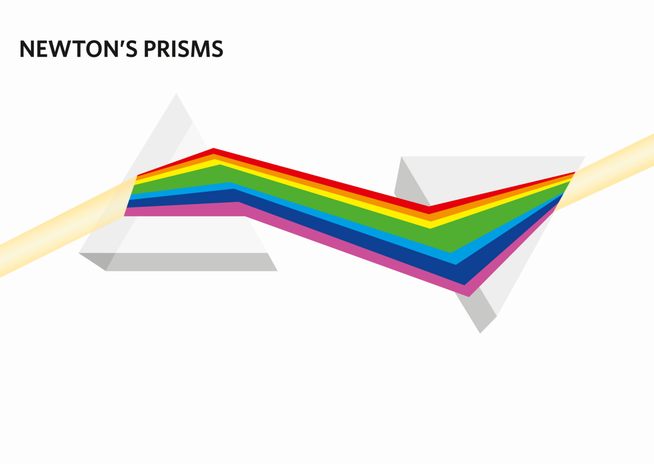Why the Sky is Blue - Scientific & Ancient Explaination
 |
It's easy to see that the sky is blue. Have you ever wondered why?
The Short Answer for the Sky is BlueSunlight reaches Earth's atmosphere and is scattered in all directions by all the gases and particles in the air. Blue light is scattered more than the other colors because it travels as shorter, smaller waves. This is why we see a blue sky most of the time. |
Why the sky is blue - Scientific explanation
According to Scientific America, Anthony D. Del Genio of the NASA Goddard Institute for Space Studies and Columbia University explains the reason why the sky is blue as follow:
To understand why the sky is blue, we need to consider the nature of sunlight and how it interacts with the gas molecules that make up our atmosphere. Sunlight, which appears white to the human eye, is a mixture of all the colors of the rainbow. For many purposes, sunlight can be thought of as an electromagnetic wave that causes the charged particles (electrons and protons) inside air molecules to oscillate up and down as the sunlight passes through the atmosphere. When this happens, the oscillating charges produce electromagnetic radiation at the same frequency as the incoming sunlight but spread over all different directions. This redirecting of incoming sunlight by air molecules is called scattering.
The blue component of the spectrum of visible light has shorter wavelengths and higher frequencies than the red component. Thus, as the sunlight of all colors passes through the air, the blue part causes charged particles to oscillate faster than does the red part. The faster the oscillation, the more scattered light is produced, so blue is scattered more strongly than red. For particles such as air molecules that are much smaller than the wavelengths of visible light, the difference is dramatic. The acceleration of the charged particles is proportional to the square of the frequency, and the intensity of scattered light is proportional to the square of this acceleration. Scattered light intensity is therefore proportional to the fourth power of frequency. The result is that blue light is scattered into other directions almost 10 times as efficiently as red light.
When we look at an arbitrary point in the sky, away from the sun, we see only the light that was redirected by the atmosphere into our line of sight. Because that occurs much more often for blue light than for red, the sky appears blue. Violet light is actually scattered even a bit more strongly than blue. More of the sunlight entering the atmosphere is blue than violet, however, and our eyes are somewhat more sensitive to blue light than to violet light, so the sky appears blue.
 |
| John Tyndall. (Photo: Conversation) |
Who found out the reason?
John Tyndall, the Irish physicist was born on August 2 in 1820 and is remembered by many as the man who first explained why the sky is blue. This discovery, known as the Tyndall effect, proves the sky’s blue color results from the scattering of the Sun’s rays by molecules in the atmosphere.
Tyndall's major scientific contributions were in physical chemistry, initially with the study of diamagnetism, and then thermal radiation – producing a number of discoveries in atmospheric processes. His experimental physics and resulting discoveries were brought to a wider audience through the publication of seventeen books during the 19th century.
Other major experiments from Tyndall include the transmission of both radiant heat and light through various gases and vapors. Tyndall discovered that water vapor absorbs much more radiant heat than the gases of the atmosphere and argued the consequent importance of atmospheric water vapor in moderating the Earth’s climate—that is, in the natural greenhouse effect. He is also credited with the first-ever atmospheric pollution measurements using infra-red and scattering measurement instruments, showing that ozone, the upper layer of the atmosphere, is vital to life on Earth, and it is an oxygen cluster rather than a hydrogen compound.
Tyndall laid the significant groundwork in physics for magnetism, electricity, molecular physics, optics, sound, the properties of materials, diamagnetism, and heat.
 |
| Photo: Cosmo |
Why sky turns red in the sunset?
During sunrise/sunset or moonrise/moonset, the light coming from the Sun (or Moon) itself has to pass through tremendous amounts of the atmosphere; the closer to the horizon it is, the more atmosphere the light must pass through. While the blue light gets scattered in all directions, the red light scatters much less efficiently. This means that both the light from the Sun's (or Moon's) disk itself turns a reddish color, but also the light from the vicinity of the Sun and Moon — the light that hits the atmosphere and scatters just once before reaching our eyes — is preferentially reddened at that time.
And during a total solar eclipse, when the Moon's shadow falls over you and prevents direct sunlight from hitting large sections of the atmosphere near you, the horizon turns red, but no place else. The light striking the atmosphere outside the path of totality gets scattered in all directions, which is why the sky is still visibly blue in most places. But near the horizon, that light that gets scattered in all directions is very likely to get scattered again before it reaches your eyes. The red light is the most likely wavelength of light to get through, eventually surpassing the more efficiently scattered blue light, Forbes cited.
 |
| Photo: Cosmo |
Is the sky blue on other planets?
The atmosphere is normally the outermost layer of a planet. On rocky worlds like Earth, it is usually the lightest and thinnest layer. Atmospheres can contain a wide variety of gases. Most of Earth’s atmosphere is a gas called nitrogen that doesn’t really react with anything. There’s also a fair bit of oxygen, which is what we need to breathe. There are also two other important gases called argon and carbon dioxide, and tiny amounts of lots of other ones. The mix of gases is what gives a planet’s atmosphere its color. Earth’s atmosphere is made up of gases that tend to bounce blue light in all directions (known as “scattering”) but let most other colors of light straight through. This scattered light is what gives Earth’s atmosphere its blue color.
The atmospheres of the two ice giants in our solar system, Neptune and Uranus, are both beautiful shades of blue. However, these atmospheres are a different blue than ours. It’s caused by the huge amounts of a gas called methane swirling around, according to ABC Education.
Jupiter and Saturn, however, have completely different-colored atmospheres. Ice crystals made of a chemical called ammonia in Saturn’s upper atmosphere make it a pale shade of yellow. Uranus’ atmosphere also contains some ammonia, which makes the planet a slightly greener shade than the deep blue we see on Neptune. Jupiter’s atmosphere has distinctive brown and orange bands, thanks to gases that may contain the elements phosphorus and sulfur, and possibly even more complicated chemicals called hydrocarbons.
In some extreme cases, the entire planet might just be a huge atmosphere with no rocky surface at all. Astronomers and planetary scientists like myself are still trying to work out whether Jupiter and Saturn have rocky surfaces, deep down in their atmosphere, or whether they’re both simply huge balls of gas.
However, there are some planets that have no atmosphere at all! The Sun’s closest and smallest neighbor, Mercury, is one example. Its surface is exposed to the vastness of space.
Astronomers have been detecting the atmospheres of these planets (which we call “exoplanets”) for the past 20 years! It wasn’t until last year, however, that astronomers managed to detect the atmosphere of a rocky exoplanet. The planet is called LHS 3844b and it’s so far away that the light takes almost 50 years to reach us! LHS 3844b weighs twice as much as Earth, and we astronomers thought it would have a pretty thick atmosphere. But, to our surprise, it has little to no atmosphere at all! So it might be more like Mercury than Earth. We still have a lot to learn about far-off planets, and discovering one with an Earth-like atmosphere that’s ripe for life is still many years away.
 |
| Color of sky described by Greek mythology. (Photo: Slightly Blue |
Why no older explanation found?
The question "why the sky is blue" was actually solved rather early by scientists. But in most mythology, rarely any explanation found. In Greek mythology, the story goes that one day Zeus, the Greek god of the sky, asked his daughter Athena to make a wish. The greyish-blue-eyed Athena, wrapped up in herself, wished that the world could see her beauty every single day. Zeus granted Athena’s wish by turning the sky is gray-blue, the color of her beautiful eyes.
In the entire ancient Greek literature, there is not a single pure blue sea or sky. Ancient Greeks had two words for blue: "kuaneos", a dark shade of black-blue, and "glaukos", which denotes a sort of blue-grey, as in Athena's epithet "glaukopis", her grey-gleaming eyes. In the Odyssey, Homer famously describes the “wine-dark sea.” But why “wine-dark” and not deep blue or green? Ancient languages didn’t have a word for blue — not Greek, not Chinese, not Japanese, not Hebrew. And without a word for the color, there’s evidence that they may not have seen it at all.
So Gladstone decided to count the color references in the book. And while black is mentioned almost 200 times and white around 100, other colors are rare. Red is mentioned fewer than 15 times, and yellow and green fewer than 10. Gladstone started looking at other ancient Greek texts, and noticed the same thing — there was never anything described as “blue.” The word didn’t even exist. It seemed the Greeks lived in a murky and muddy world, devoid of color, mostly black and white and metallic, with occasional flashes of red or yellow.
Gladstone thought this was perhaps something unique to the Greeks, but a philologist named Lazarus Geiger followed up on his work and noticed this was true across cultures. He studied Icelandic sagas, the Koran, ancient Chinese stories, and an ancient Hebrew version of the Bible. Of Hindu Vedic hymns, he wrote: “These hymns, of more than ten thousand lines, are brimming with descriptions of the heavens. Scarcely any subject is evoked more frequently. The sun and reddening dawn’s play of color, day and night, cloud and lightning, the air and ether, all these are unfolded before us, again and again… but there is one thing no one would ever learn from these ancient songs… and that is that the sky is blue.” There was no blue.
According to Business Insider, one researcher that Radiolab spoke with — Guy Deutscher, author of “Through the Language Glass: Why the World Looks Different in Other Languages,” tried a casual experiment with that. In theory, one of the children’s first questions is “why is the sky blue?” So he raised his daughter while being careful to never describe the color of the sky to her, and then one day asked her what color she saw when she looked up. Alma, Deutscher’s daughter, had no idea. The sky was colorless. Eventually, she decided it was white, and later on, eventually blue. But it wasn’t the first thing she saw or gravitated towards, though it is where she settled in the end.
Without a word for a color, without a way of identifying it as different, it’s much harder for us to notice what’s unique about it — even though our eyes are physically seeing the blocks in the same way. So before blue became a common concept, maybe humans saw it. But it seems they didn’t know they were seeing it.
 International Children’s Day: When, Why And How To Celebrate In Covid-19 International Children’s Day: When, Why And How To Celebrate In Covid-19 People the world over celebrate International Children’s Day every year. Since children hold the future of any society, it makes sense to set aside ... |
 How Many Days Are In A Week and Why Are There Seven Days? How Many Days Are In A Week and Why Are There Seven Days? Waiting for the weekend can often seem unbearable, a whole six days between Saturdays. Having seven days in a week has been the case for ... |
 What is Chinese TV drama 'Word of Honor'? Why to Watch, Cast, Coming on Netflix What is Chinese TV drama 'Word of Honor'? Why to Watch, Cast, Coming on Netflix What is the hottest online drama in China? The answer will most likely be "Word of Honor" on social media. It's not only the most-talked ... |























